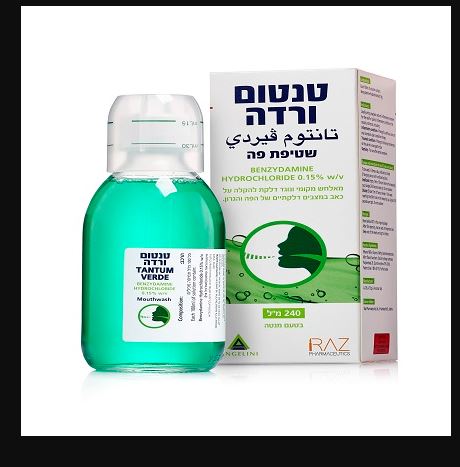Quest for the right Drug

טנטום ורדה TANTUM VERDE (BENZYDAMINE HYDROCHLORIDE)
תרופה במרשם
תרופה בסל
נרקוטיקה
ציטוטוקסיקה
צורת מתן:
פומי מקומי : LOCAL ORAL
צורת מינון:
אין פרטים : MOUTHWASH
עלון לרופא
מינוניםPosology התוויות
Indications תופעות לוואי
Adverse reactions התוויות נגד
Contraindications אינטראקציות
Interactions מינון יתר
Overdose הריון/הנקה
Pregnancy & Lactation אוכלוסיות מיוחדות
Special populations תכונות פרמקולוגיות
Pharmacological properties מידע רוקחי
Pharmaceutical particulars אזהרת שימוש
Special Warning עלון לרופא
Physicians Leaflet
Pharmacological properties : תכונות פרמקולוגיות
Pharmacodynamic Properties
5.1 Pharmacodynamic properties Pharmacotherapeutic group: Other substances for local oral treatment. ATC code: A01AD02 Mechanism of action The indazole analogue benzydamine has physicochemical properties and pharmacological activities which differ from those of the aspirin-like NSAIDs. Unlike aspirin-like NSAIDs which are acids or metabolised to acids, benzydamine is a weak base. In further contrast, benzydamine is a weak inhibitor of the prostaglandin synthesis. Only at concentration of 1mM and above benzydamine effectively inhibits cyclooxygenase and lipooxygenase enzyme activity. It mostly exerts its effects through inhibition of the synthesis of proinflammatory cytokines including tumour necrosis factor-alpha (TNF-α) and Interleukin-1β (IL-1β) without significantly affecting other pro-inflammatory (IL-6 and 8) or anti-inflammatory cytokines (IL-10, IL-1 receptor antagonist). Further mechanisms of action are hypothesised including the inhibition of the oxidative burst of neutrophils as well as membrane stabilisation as demonstrated by the inhibition of granule release from neutrophils and the stabilization of lysosomes. The local anaesthetic activity of the compound has been related to an interaction with cationic channels. Pharmacodynamic effects Benzydamine specifically acts on the local mechanisms of inflammation such as pain, oedema or granuloma. Benzydamine topically applied demonstrates anti-inflammatory activity reducing oedema as well as exudate and granuloma formation. Further, it exhibits analgesic properties if pain is caused by an inflammatory condition and local anaesthetic activity. Hyperthermia, which is indicative of systemic functional involvement, is poorly affected by benzydamine. Clinical efficacy and safety In a clinical study in 24 patients with pharyngitis following tonsillectomy rinsing with Benzydamine 0.15%, 5 times a day for 6 days significantly better and more rapidly relieved throat pain, difficulty in swallowing and improved clinical signs including hyperaemia and oedema versus placebo on day 7. Similar results were found in other studies in patients with tonsillitis or pharyngitis or following dental surgery. The gargling with 30 ml 0.075% benzydamine prior to the induction of anaesthesia in 58 adults undergoing general anaesthesia with endotracheal tube intubation significantly reduced postoperative sore throat versus water control for the first 24 hours whereas aspirin gargles reduced it for 4 hours. In a clinical study with 48 patients rinsing four times daily with 0.15% benzydamine during a 3 to 5-week radiotherapy of oral cancer provided significant pain relief and reduction of size and severity of mucositis in the oropharynx. Similar effects were seen in a study in patients undergoing chemotherapy for oral cancer. In a study in 67 patients with severe oropharyngeal mucositis following radiotherapy who rinsed with benzydamine solution, pain with swallowing, hyperaemia and severity of mucositis were significantly reduced compared to placebo treatment within the first three treatment days. A higher incidence of transient numbness and stinging was noted among the patients using benzydamine that was attributed to the medication's local anaesthetic effect. The topical application of Benzydamine Hcl cream 3%, 3 times daily for 6 days in 50 patients with soft tissue injuries significantly better relieved pain, tenderness, erythema, functional impairment and swelling compared to placebo on day 6. Overall, benzydamine was well tolerated in clinical trials.
Pharmacokinetic Properties
5.2 Pharmacokinetic properties Oral doses of benzydamine are well absorbed and plasma drug concentrations reach a peak fairly rapidly and then decline with a half-life of about 13 hours. Less than 20% of the drug is bound to plasma proteins. Although local drug concentrations are relatively large, the systemic absorption of mouthwash-gargle doses of benzydamine is relatively low compared to oral doses. This low absorption should greatly diminish the potential for any systemic drug side-effects when benzydamine is administered by this route. Benzydamine is metabolized primarily by oxidation, conjugation and dealkylation.

שימוש לפי פנקס קופ''ח כללית 1994
לא צוין
תאריך הכללה מקורי בסל
לא צוין
הגבלות
לא צוין
מידע נוסף
עלון מידע לצרכן
07.08.22 - עלון לצרכן אנגלית 07.08.22 - עלון לצרכן עברית 27.11.19 - עלון לצרכן ערבית 19.09.22 - עלון לצרכן אנגלית 19.09.22 - עלון לצרכן עברית 19.09.22 - עלון לצרכן ערבית 05.09.24 - עלון לצרכן עברית 07.11.24 - עלון לצרכן עברית 07.11.24 - עלון לצרכן ערבית 10.01.16 - החמרה לעלון 07.08.22 - החמרה לעלון 18.09.22 - החמרה לעלון 19.09.22 - החמרה לעלון 17.09.24 - החמרה לעלוןלתרופה במאגר משרד הבריאות
טנטום ורדה